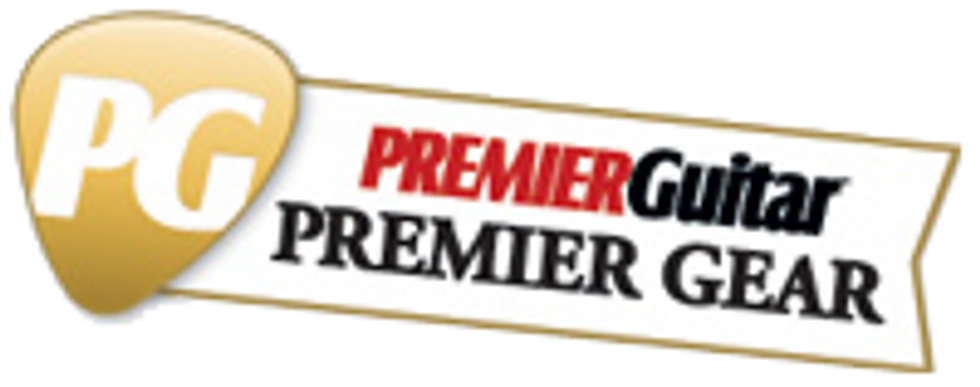Most of us are conditioned to respond to the claim of a “unique” amp design with a mixture of bemusement, skepticism, and/or horror. If it’s a digital amp, many will roll their eyes and cough disbelieving comments under their breath. If the allegedly unique amp uses tubes, some players might listen a little longer—probably still convinced they’re about to fall prey view to marketing mumbo-jumbo.
With the new Fryette Aether, though, the difference is right there in front of you and you can’t help but be intrigued by the unusual execution. Not quite head and cab, not quite a combo, it’s comprised of two boxes: A small metal unit that looks a bit like a ’50s lunchbox and contains the power tubes (two 6L6s), rectifiers (two 5Y3s), and transformers, and an XLR cable and 1/4" speaker cable that links that box to a Baltic birch cab housing the preamp, tone-altering controls, and a custom 12" Fane A60S speaker.
According to designer Steven Fryette, the Aether’s unusual design is intended to prolong power-tube life by separating the 6L6s from the speaker’s magnetic fields and filament-jostling bass frequencies, and to prevent electrical “noise” from the power circuit from transferring to the preamp’s signal path. Once you switch the lunchbox on and take a look at the main control panel, Aether seems pretty straight ahead. Twenty-five watts feed a single channel whose two 12AX7s, one 12AT7, and single 6SN7 phase inverter drive a control set with volume, a brite switch, a 2-band EQ, tremolo speed and intensity knobs, and a reverb control. But look closely and you’ll note that the bass and treble knobs are labeled “boost” and “cut” at their extremes. These active controls are key to the Aether’s surprisingly diverse tones.
Sonics Snatched from the Heavens
I tested the Aether with a couple of Telecasters (one with Curtis Novak pickups, the other with Nordstrand NVT A3s), Danelectro and Eastwood baritones (the latter with Manlius Jazzmaster-style pickups), and a TV Jones Magna’Tron-loaded Schecter Ultra III. Upon plugging in, the first things I noticed were how vintage and lived-in Aether sounds, yet how full-sounding and authoritative it is. This is certainly attributable to its construction methodology and the sum of its parts, but the preamp and speakers seem particularly important.
Ratings
Pros:
Active circuitry yields fantastic range of beautiful, authoritative tones. Fantastically deep spring reverb. Hypnotic tremolo.
Cons:
Expensive. No footswitch for reverb or tremolo.
Tones:
Ease of Use:
Build/Design:
Value:

Street:
$4,499
Fryette Aether
fryette.com
Two EQ knobs can seem pretty barebones, but that’s because most of us are used to passive EQs. At noon, Aether’s bass and treble knobs are flat—they’re not cutting or boosting any frequencies, so the pure voice of the preamp comes through. Past 12, they increase the volume of certain frequencies, while setting them under 12 attenuates (removes) frequencies. (In contrast, passive EQ knobs—like those on a Twin or a Marshall plexi—are actually removing frequencies from the circuit unless they’re all the way up.)
What’s so powerful about an EQ like the Aether’s is how interactive the tone controls are—both with themselves and the volume. Boost bass from noon to, say, 2 o’clock, and not only do you get more bass, but you’ve re-voiced the treble knob’s response. The dynamic possibilities here are deliciously drastic: With bass and treble at 2 o’clock and volume past noon, you’ve got a raucous tone that barks with authority and stays detailed across the frequency spectrum—think cranked Deluxe with way more muscle. Crank the bass up further and suddenly you’ve got the wooly swagger of an old Marshall or Bassman going for broke. Dial treble back past 9 o’clock, toward minimum, and you’ve got a mixture of midrange honk and Vox-like character. With tamer volume settings, you can get all manner of jazzy or rootsy tones—especially with the lunchbox’s dampening circuit set to light—and the brite switch is fantastic for taming the fizziness of, say, a Tele’s bridge pickup without losing its defining character.
As I mentioned, the Aether’s other crucial component is its alnico Fane speaker. I’ve never thought about speakers this way before, but Fryette describes the response of the A60S—which he spent two years developing with Fane Acoustics in the U.K.—as having more of an “ahhh” vowel sound that emphasizes fundamentals, as opposed to a Celestion’s “ee” sound that lends emphasis to harmonics. This jives perfectly with how I experienced the Aether’s big sound. The cab isn’t particularly large or deep, yet at higher volumes it resonates with a pleasing, all-encompassing energy that belies its dimensions.
To top things off, the amp’s long-pan reverb is alluringly expansive—reverb junkies will bask in its sloshing warmth. Even the tremolo benefits from the Aether’s active circuitry— boosting rather than cutting each signal undulation in a manner that’s simultaneously engrossing and empowering.
The Verdict
I’m not really qualified to judge the technical aspects of Steven Fryette’s highly unusual Aether setup, although practically speaking, splitting the total package weight of 45 pounds into two boxes that roughly balance each other out makes for a pretty easy haul to and from a gig. But even if I had some sort of theoretical basis for challenging the technical rationale behind the design (check out our in-depth video interview and demo from the last NAMM show), the Aether’s sounds are so exquisite and engulfing—and have so little extraneous noise—that it’s hard to believe Fryette’s not on to something here. This is one of the most rewarding, morphable, and sonically pleasing amps I’ve ever had the pleasure of playing.








![Rig Rundown: Russian Circles’ Mike Sullivan [2025]](https://www.premierguitar.com/media-library/youtube.jpg?id=62303631&width=1245&height=700&quality=70&coordinates=0%2C0%2C0%2C0)


























